
Power steering is standard on every Nissan vehicle. Many power steering systems rely on pressurized hydraulic fluid. It transmits the power used when turning the steering wheel with a power assist that actuates a much greater force to turn the wheel and tire assembly. This provides power assistance and reduced steering effort while driving in a variety of conditions. The rack and pinion assembly is a vital component of this system that converts the rotational motion of the steering wheel and transfers the energy of the pressurized fluid into a linear motion to turn the wheels. It responds to movements of the steering wheel to steer the wheels in the corresponding direction. If the pressurized hydraulic fluid is lessened or removed from the steering system, customers may begin to hear abnormal noises or experience heavier than normal steering effort. In this article, we will discuss what to look for when your customers experience these symptoms and you suspect the rack and pinion may be leaking.



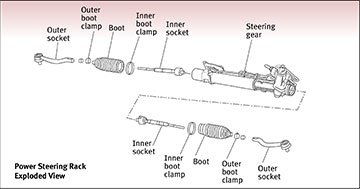
COMMONLY OBSERVED CONDITIONS - When inspecting the rack and pinion assembly, you may notice some accumulation of residue that can indicate an early warning sign of leakage. It is important to know which conditions are indicative of a leak to avoid unnecessary repairs that may influence your customer’s confidence in his or her vehicle’s durability.
The two most common areas where residue may be seen are the pinion gear adjustment nut and the area where the boots clamp to the rack assembly.
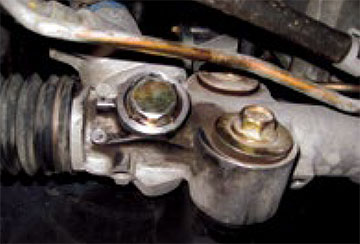
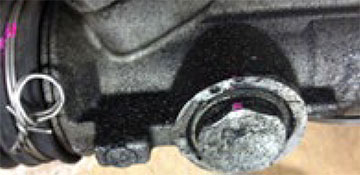
You may observe a sticky yellow substance or wet appearance with dirt accumulation on the adjustment nut below the rotary valve body. This is not usually indicative of a power steering fluid leak as this adjustment nut is not a fluid sealing surface. Using a cotton swab, dab the substance and determine if it’s color and texture match the type of fluid in the reservoir. Genuine Nissan Power Steering Fluid is RED in color and oily in texture and may become reddish-brown with higher vehicle mileage. If the observed substance does not match, then it is not a sign of a power steering fluid leak. It is recommended to clean this area and observe its appearance at future appointments.
Similarly, you may notice dirt and road debris adhering to the areas near the end of the boots, and you may even see boots with an oily appearance as well. This can be deceiving. In order to prevent water intrusion into the boots and subsequently into the delicate sealing surfaces protected by the boots, the lips of the boots are lined with grease in the manufacturing process. When the clamps are tightened down, this grease may have squeezed outward onto the rack assembly. If not completely cleaned, the remaining grease residue will collect dirt, dust, and grime that will be seen on the undercarriage of the vehicle. Additionally, if the rack and pinion assembly was stored vertically prior to its installation, power steering fluid may run down the side of the rack body and collect at the lip of the boot. Units that have a large accumulation of fluid residue on one side but little to none on the other side are often the result of being vertically stored. This observed condition is not really an indication of a power steering fluid leak, so it is recommended to clean this area thoroughly and look for the same appearance at future appointments.
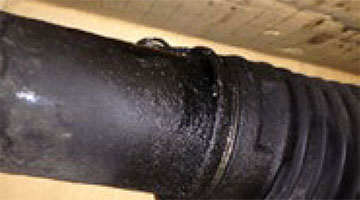
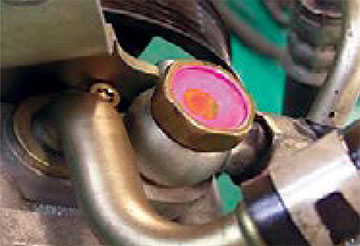
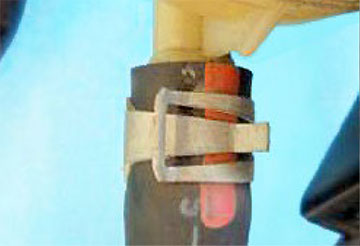
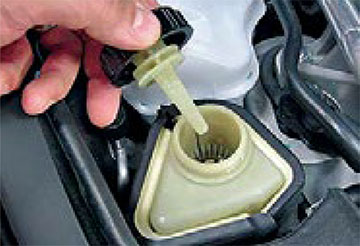
LEAK CONDITIONS - If a customer is experiencing reduced power steering assistance or a whining noise from the power steering pump, there is a good chance that a leak from the power steering system may be the culprit. Depending on the type of leak, there may or may not be an obvious puddle of fluid under the vehicle. The following information will provide you with some tips to narrow down the source of concern.
When a leak is suspected from the steering system, a good place to begin investigating is to check the fluid level in the reservoir. Is the fluid level within specification? If it is very low or empty, you should start searching for the leak source. Hoses and fittings should be carefully checked for the presence of power steering fluid. If you find fluid residue on a hose, on a fitting, or on the steering rack, it is best to clean that area and cycle the steering system. A leak located higher in the engine compartment may drip or flow down the hoses to the steering rack. Starting your search after cleaning the components will help you find the true leak source.
If the reservoir level is very low and all components show no immediate signs of leakage, you should focus your attention on the steering rack. The fittings at the rack should be checked for signs of a leak, and if found, check for tightness. If the fitting has somehow become loose, it is a simple repair to retighten it to specification. With a leak of this type, you may find some power steering fluid has dripped down to the pinion gear adjustment nut. The nut itself is an unlikely leak source, so be sure to verify the fluid residue found matches the type of power steering fluid used in the system. Also, check the fittings directly above for the source.
The final areas that should be checked on the steering rack are the boots that protect the inner tie rod seals. If fluid leaks past these seals, it will begin to fill in the boot. Because these boots are made to keep intrusive water and contamination away from the seals, it is unlikely for leaking fluid to exit them without significant pressure applied. The type of material used to manufacture these boots tends to absorb the power steering fluid and will give it a shiny, or black waxed appearance from the outside and become soft to the touch.Do the boots appear firm and dry or shiny and soft?
It is not uncommon for fluid from other sources on the vehicle or from the road to splash onto the boots and give them a wet appearance. If it is unclear if fluid is leaking into the boot, you may need to go one step further to verify its condition. However, steering racks for some vehicles are equipped with boots that are not serviceable as replacement clamps for these models are not available as service parts. The Service Manuals for these models do not advise the removal of these types of boots. Steering racks that utilize a twisted wire to clamp the boot to the rack housing are often serviceable. You may remove this type of clamp and pull the boot back to check inside. Refer to the applicable vehicle’s Service Manual for the appropriate procedure and always thoroughly clean the area around the boot before disassembly as any contamination that enters this area can cause a leak later. When a leak occurs in this area, many times it will pour out once the boot is pulled back. If you don’t see this, grab a flashlight and check inside. Does the boot appear wet or dry? You will likely see some yellow grease residue and sometimes some areas that appear wet from this grease. It is best to use a cotton swab on the wet areas and check the color and texture of what you see. If the substance is greasy and yellow, there is no indication of a leak. From here, you may place the boot back in its original location and use a new clamp to secure it to the rack assembly. If the residue is thinner and matches the color of the fluid used in the power steering system, the leak source has been identified and a repair should be performed.
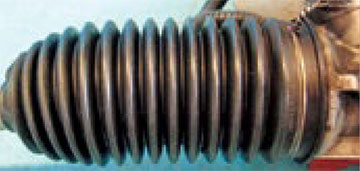
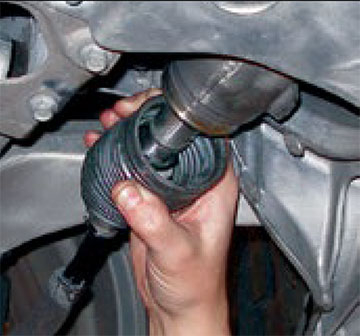
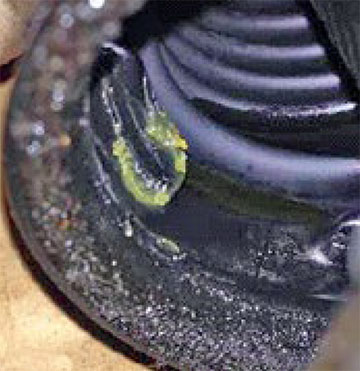
Inspect boots with a shiny, black appearance and check inside boot
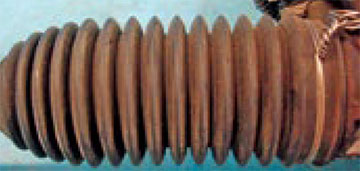
Okay, not leaking
If a customer is experiencing steering that’s much harder to operate than normal, there is a good chance that a leak from the power steering system may be the root cause of his or her vehicle’s power steering diminished responsiveness.
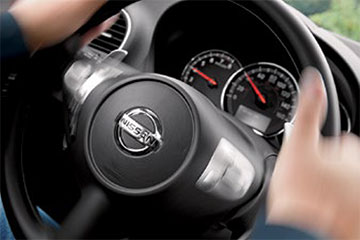
![]()
Do not reuse boot clamps. Reusing clamps may cause the boot to be installed either too loosely or too tightly, which could result in early boot wear and cracking.